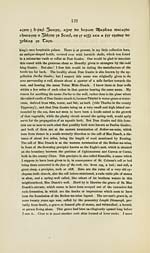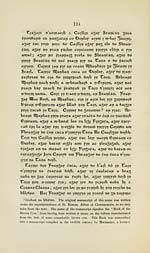Download files
Complete book:
Individual page:
Thumbnail gallery: Grid view | List view

where Guaire resides ; and we shall get Marvan the
swineherd to come to us from Glen-a-scail, for it is he who
knows how the Tain may be obtained."
refer you to the pages of the Foras Feasa for the story from which Keating
derives the appellation Bothar-na-mias, ' road of the dishes,' or, as I heard it
called by a Roman Catholic clergyman, who was a good Irish scholar, and is
long dead, Bothar-/ea»a7tocA-na-mias, ' the road of follmcing the dishes ;' and
also as to the good and miraculous offices related to have been performed for
St. Colman, alias Mac Duach, here by his cock, his mouse, and his fly. Dr.
Lanigan, (Eccl. Hist.), charges Keating in regard to these stories with having
picked up some '^ prodigious fables' concerning this saint. I strongly suspect
that the term bócATi tjA njjAf originally meant the ahar-\a.n^ or road, before
the Romancer had turned it into the road of the dishes, for tijiAf signifies
an altar as well as a dish. In O'Brien's Dictionary, ad verb, bot^tt, that
reverend writer describes Bothar-na-mias as ' a way between Durlus Guaire in
tlie county Galway and Mochua's well, or St. Mac Duach's hermitage in Buf-
ren, county Clare.' Dr. Lanigan denies that St. Mac Duach was called Mochua,
and corrects others respecting it.
" With regard to another place which you seek the site of, viz. Eregal or
Aragal-na-feile, it seems to me that this was but another name for the Cell or
Bed of St. Mac Duach, already mentioned by the name Kinnallia, as situate
under the Raven's nest. It must be borne in mind, that it was to this cell St.
Colman's prayers miraculously transported the sumptuous dinner of king
Guaire from Durlus Guaire, for the gratification of the saint's clerk or attend-
ant. Hence it might be denominated not improperly Aracul or Aragul (c and
5 being commutable) na-feile — AttACUl meaning a cell, grotto, or retired dwell-
ing ; and jréjle, which signifies hospitality, being sometimes used to express the
feast itself. Thus Aragal-na-feile would mean the Cell of the feast, which the
cell of St. Mac Duach under the Raven's nest, in reality was, supposing the
legend of the dishes' asportation to be true. This cell you must bear in mind
was at the western end of the Bothar-na-mias. I do not remember the name (if
I ever knew it) of the hermit who attended St. Mac Duach here in the woods
and fastnesses of Burren.
" Gleann-an-scail, or the valley of the shadow. There are various gloomy
valleys in that neighbourhood. As the lofty precipice over St. Mac Duach's
cell runs from N.N.E. to S.S.W. the afternoon sun casts a very long shadow
from it on the valley (Longesque cadunt de montibus umbrae). This might
account for that vale being called Glen-a-scail ; or, perhaps, some warrior
named Seal fell there in days of old. Some remarkable person, I suppose, was
interred in the Cairn on the summit of Slieve-Carne, which gives a name to
the parish uf Carron, and is immediately over the cell of St. Mac Duach."
swineherd to come to us from Glen-a-scail, for it is he who
knows how the Tain may be obtained."
refer you to the pages of the Foras Feasa for the story from which Keating
derives the appellation Bothar-na-mias, ' road of the dishes,' or, as I heard it
called by a Roman Catholic clergyman, who was a good Irish scholar, and is
long dead, Bothar-/ea»a7tocA-na-mias, ' the road of follmcing the dishes ;' and
also as to the good and miraculous offices related to have been performed for
St. Colman, alias Mac Duach, here by his cock, his mouse, and his fly. Dr.
Lanigan, (Eccl. Hist.), charges Keating in regard to these stories with having
picked up some '^ prodigious fables' concerning this saint. I strongly suspect
that the term bócATi tjA njjAf originally meant the ahar-\a.n^ or road, before
the Romancer had turned it into the road of the dishes, for tijiAf signifies
an altar as well as a dish. In O'Brien's Dictionary, ad verb, bot^tt, that
reverend writer describes Bothar-na-mias as ' a way between Durlus Guaire in
tlie county Galway and Mochua's well, or St. Mac Duach's hermitage in Buf-
ren, county Clare.' Dr. Lanigan denies that St. Mac Duach was called Mochua,
and corrects others respecting it.
" With regard to another place which you seek the site of, viz. Eregal or
Aragal-na-feile, it seems to me that this was but another name for the Cell or
Bed of St. Mac Duach, already mentioned by the name Kinnallia, as situate
under the Raven's nest. It must be borne in mind, that it was to this cell St.
Colman's prayers miraculously transported the sumptuous dinner of king
Guaire from Durlus Guaire, for the gratification of the saint's clerk or attend-
ant. Hence it might be denominated not improperly Aracul or Aragul (c and
5 being commutable) na-feile — AttACUl meaning a cell, grotto, or retired dwell-
ing ; and jréjle, which signifies hospitality, being sometimes used to express the
feast itself. Thus Aragal-na-feile would mean the Cell of the feast, which the
cell of St. Mac Duach under the Raven's nest, in reality was, supposing the
legend of the dishes' asportation to be true. This cell you must bear in mind
was at the western end of the Bothar-na-mias. I do not remember the name (if
I ever knew it) of the hermit who attended St. Mac Duach here in the woods
and fastnesses of Burren.
" Gleann-an-scail, or the valley of the shadow. There are various gloomy
valleys in that neighbourhood. As the lofty precipice over St. Mac Duach's
cell runs from N.N.E. to S.S.W. the afternoon sun casts a very long shadow
from it on the valley (Longesque cadunt de montibus umbrae). This might
account for that vale being called Glen-a-scail ; or, perhaps, some warrior
named Seal fell there in days of old. Some remarkable person, I suppose, was
interred in the Cairn on the summit of Slieve-Carne, which gives a name to
the parish uf Carron, and is immediately over the cell of St. Mac Duach."
Set display mode to: Large image | Transcription
Images and transcriptions on this page, including medium image downloads, may be used under the Creative Commons Attribution 4.0 International Licence unless otherwise stated. ![]()
| Early Gaelic Book Collections > J. F. Campbell Collection > Transactions of the Ossianic Society > Volume 5 > (163) |
|---|
| Permanent URL | https://digital.nls.uk/82283765 |
|---|
| Description | Dublin : Printed under the direction of the Council, 1854-1861. |
|---|---|
| Shelfmark | Cam.1.c.5-10 |
| Additional NLS resources: | |
| Description | Volumes from a collection of 610 books rich in Highland folklore, Ossianic literature and other Celtic subjects. Many of the books annotated by John Francis Campbell of Islay, who assembled the collection. |
|---|
| Description | Selected items from five 'Special and Named Printed Collections'. Includes books in Gaelic and other Celtic languages, works about the Gaels, their languages, literature, culture and history. |
|---|

